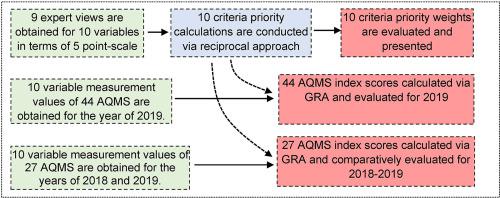Atmospheric Pollution Research ( IF 3.9 ) Pub Date : 2021-03-24 , DOI: 10.1016/j.apr.2021.03.009 Özgür Zeydan , Mehmet Pekkaya

|
The monitoring of air pollutants is required to manage the air quality in cities. The main purposes of this paper are determining the priorities of air pollutants, and evaluating the air quality monitoring stations (AQMS) in Turkey by calculating their air pollution indexes via multi-criteria decision making (MCDM) methods. For calculation of index scores, concentration and threshold exceedance data of 44 AQMS, measured 5 air pollutants (PM10, SO2, CO, NO2, and O3) at the same time, are included in analysis. Criteria priorities of concentrations and threshold exceedances are determined by using experts’ views. Air pollution indexes are calculated for 2019 employing the grey relational analysis (GRA) method of the MCDM approach. Moreover, a relative pollution level transition diagram is constructed to compare the differences between 2018 and 2019. According to the results, the priority of PM10 is observed as about 2.5 times more important than NO2. Threshold limits exceedance number priorities of air pollutants criteria are about 1/3 times more important than concentrations of air pollutants according to the experts. PM10 was the most important pollutant due to its high concentrations and the high number of limit exceedances. Çanakkale-Biga station has the best air quality among 44 AQMS. Ankara-Siteler station is evaluated as the most polluted station. The results of this study indicated that the air quality of stations located near industrial zones and thermal power plants was poorer than other AQMS. This study showed that calculated air pollution index scores can be used for ranking and comparatively evaluating AQMS.
中文翻译:

通过多标准决策评估土耳其的空气质量监测站
需要监测空气污染物以管理城市的空气质量。本文的主要目的是确定空气污染物的优先级,并通过多准则决策(MCDM)方法计算其空气污染指数来评估土耳其的空气质量监测站(AQMS)。为了计算44个AQMS的指数得分,浓度和阈值超出数据,测量了5种空气污染物(PM 10,SO 2,CO,NO 2和O 3),同时包含在分析中。浓度和阈值超标的标准优先级是通过专家的意见确定的。使用MCDM方法的灰色关联分析(GRA)方法计算2019年的空气污染指数。此外,构建了一个相对污染水平过渡图以比较2018年和2019年之间的差异。根据结果,观察到PM 10的优先级比NO 2高约2.5倍。根据专家的说法,空气污染物标准的阈值超限数量优先事项比空气污染物的浓度重要约1/3倍。下午10点它是最重要的污染物,因为其浓度高且超过了极限限值。Çanakkale-Biga车站的空气质量在44个AQMS中名列前茅。安卡拉-塞特勒站被认为是污染最严重的站。这项研究的结果表明,位于工业区和火力发电厂附近的电站的空气质量较其他空气质量管理系统差。这项研究表明,计算出的空气污染指数得分可用于对AQMS进行排名和比较评估。











































 京公网安备 11010802027423号
京公网安备 11010802027423号